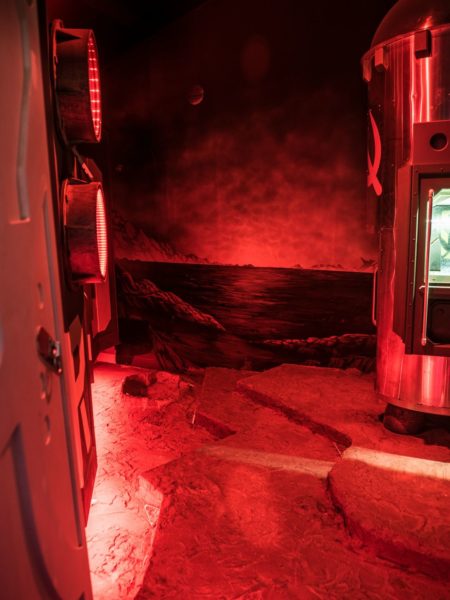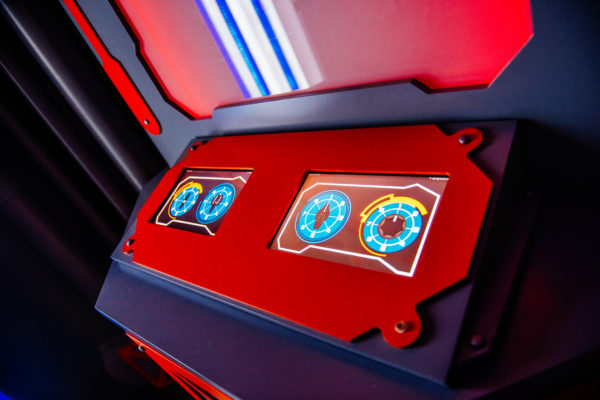RATING: 5 Keys RESULT: Win REMAINING: 19:58
Set off on an epic, perilous voyage to the Red Planet that’s so heavily story-driven, we don’t even care if we ever make it back home to Earth!

 You’ve just landed on the red planet for an exploratory mission, but your spacecraft experienced some major damage on the descent. Unfortunately, there is a larger problem at hand: a fatal amount of cosmic radiation is heading towards Mars, which will cause serious damage to the control systems, making it impossible to get back home. You have exactly 60 minutes to repair your ship and launch if you ever want to see Earth again. Godspeed!
You’ve just landed on the red planet for an exploratory mission, but your spacecraft experienced some major damage on the descent. Unfortunately, there is a larger problem at hand: a fatal amount of cosmic radiation is heading towards Mars, which will cause serious damage to the control systems, making it impossible to get back home. You have exactly 60 minutes to repair your ship and launch if you ever want to see Earth again. Godspeed!
Like any classic movie about outer space adventure, we’ve achieved the unachievable, but then something goes terribly wrong! The difference this time, though, is we’re not passively sitting in the chairs of a darkened theater; much to the contrary, we are active participants ON the ship, and if we don’t get it back online fast, this ship is where our own stories end.
And here’s the problem – we have not one but several catastrophes facing us simultaneously. The oxygen system is damaged and our ship is rapidly running short of breathable air. The communication system is down, leaving us unable to radio for help to coordinate our return to Earth. And that return? It’s going to be awful difficult with our power system completely shorted out. Oh, and did I mention that whole massive solar flare of cosmic radiation thing barreling towards us, AND the fact that not one of our team is a mechanic?
Some days, you really just should have never gotten out of hypersleep.

 Mission: Mars logically takes place primarily aboard our damaged Mars Rover ship. The aesthetic is definitely well in tune with that vision – with walls cast in stark white of sharp geometric shapes, accented by sliver rivets, exposed piping and bright orange accenting trim to add a little flare.
Mission: Mars logically takes place primarily aboard our damaged Mars Rover ship. The aesthetic is definitely well in tune with that vision – with walls cast in stark white of sharp geometric shapes, accented by sliver rivets, exposed piping and bright orange accenting trim to add a little flare.
What perhaps impressed me most will go unnoticed to many that pass through the bay doors of this ship – the themed floor and ceilings throughout the space. That may seem like an insignificant detail, but whether you actively notice it or not I promise you’ll sense the increased level of immersion it creates. This very attention to detail, right down to the necessary evils like the fire sprinkler system being seamless integrated into the design shows a dedication to scenic quality on a level we just rarely find.
Part of me wishes the ship was a bit more distressed inside – after all its systems are failing which leads me to believe this may not be the latest model. A bit of scenic painting to show age, pipes that may have previously burst but have since been repaired, etc, would only further sell the space as real to me – but even untouched as is, Mission: Mars is incredibly impressive.

 I’ll state the obvious: you can’t make it all the way to Mars without the use of some pretty impressive technology. Walk in with that expectation and you’ll have a good idea of what you might find throughout the course of Mission: Mars, and it will not disappoint. This is one of the more tech-heavy games we’ve seen to date.
I’ll state the obvious: you can’t make it all the way to Mars without the use of some pretty impressive technology. Walk in with that expectation and you’ll have a good idea of what you might find throughout the course of Mission: Mars, and it will not disappoint. This is one of the more tech-heavy games we’ve seen to date.
After a bit of a rough opening puzzle step that we found to be somewhat lacking in intuitive direction, this game becomes a meteor of momentum, where every step logically builds to the next, always leaving the player with very clear direction. Perhaps the coolest thing is that even moving quickly through puzzles, we were so into the story and its clear sense of urgency that we felt like we must be running out of time, though we would later learn we had plenty left.
That level of engagement is no small feat – and comes compliments of a puzzle track so heavily embedded in the story-world that it often felt more like logical tasks we’d need to complete in real life to get the ship back online than a game we’re simply playing for fun. As mentioned in the story, the three main crises rendering the ship uncontrollable must be solved in order to have any hope of getting home. Along the way, each puzzle connects logically in a thematic way with each specific problem. Air leaks cause critical faults in the oxygen systems. A satellite needs to be activated to fix the communication systems, etc. It’s brilliant pace-making like that which transforms this from just another game to a theatrical experience, and we loved every second of it.
Even better- with each control system we return to working order, story driven video moments automatically trigger to further immerse us into the sense of adventure, connecting us to the narrative in a way that so few other games can or even try to achieve.

If we’re being completely honest, I do have one small point of contention with the overall Mission: Mars experience – this is a fantastic game that easily earned its 5 key rating – but the truth is it was less than a hair away from getting the ultra-rare 6 key score. And really, its biggest bragging right is also the one thing that kept it as a 5 (not that there’s any shame in scoring a rating that classifies it “among the best of games” by our scoring system!)
Mission: Mars is marketed as the venues first “no locks game.” For those unfamiliar, that means no padlocks, no combination locks – everything is driven by tech. And while that technically (get it?) is still absolutely true about Mission: Mars, it’s difficult to fully give that distinction when so many of the puzzle steps still yield four digit numbers. The difference here is that rather than physically turning four wheels on a padlock and opening the latch, you punch those same four numerical characters into a tablet’s digital keypad. Absolutely still tech over padlocks, but I just wish they wouldn’t use the tech as padlocks. It somewhat defeats the purpose at that point. Using the tech as tech rather than as a padlock substitute would have put this game in even rarer company, but it doesn’t change the fact that it remains even as is one of the best escape games we’ve seen – not just in Orlando, but anywhere in the United States.
You certainly have to respect the design of a game who’s one “con” isn’t even really a negative.
Bigger picture, it has often been our experience with “the big chain” venues that you typically encounter quantity over quality. I won’t name names specifically here, but I will say that the one chain who has strived to be the complete antithesis of that sentiment is The Escape Game. While others worry more about expanding rapidly without improving their quality of content or brand reputation, each new game added to The Escape Game has significantly surpassed the one that opened before it. They’re a brand that is clearly eager to improve and grow, and the end result speaks for itself.
Now, The Escape Game has a new crown jewel they have every right to be proud of. Mission: Mars is an awesome new addition to their line up, and one that is no doubt destined to impress both the casual players and experienced fanatics alike.
Show your support for Escape Authority and get social with us:

Venue: The Escape Game
Location: Orlando, Florida
Number of Games: 5
GAME SPECIFIC INFORMATION:
Duration: 60 minutes
Capacity: 8 people
Group Type: Public / You may be paired with strangers.
Cost: $37.99 per person

We thank The Escape Game for inviting us to play this game. Although complimentary admission was generously provided, that in no way impacts the opinion included within this review.




















